Trees can be a really nice asset to have on your farm, they are especially nice around the farmyard and can add value to the character of the farm enormously. There are mature deciduous trees on Irish farms dating back 150 to 200 years and some are even older still.
The people who planted those trees would never live to see them fully mature, but still took the time and effort to sow them to benefit future generations farming the land. As these trees fall over time they are a valuable source of timber for fire wood.
By planting trees on the farm, we are creating a lasting legacy for future generations to enjoy. Trees play a vital role in our environment by taking in harmful pollutants and releasing clean oxygen. They also enrich biodiversity acting as a home for birds, small mammals, insects and fungi.
Farmers do not have to sow many trees to make a difference. If your budget allows you could aim to sow a few trees every year.
The cost of trees can vary substantially, with economies of scale a big influence on price. Big trees (6-to-8mm thick) cost €20 to €35/tree from the nursery.
Small saplings (1.5ft long) cost 80c to €1.30. Prices also vary depending on labour and materials.
Saplings require a lot more time and attention to make sure they survive in the intervening years, that is why nurseries provide older trees as an option for customers.
Peadar Conway and Dominic Cassidy from Conway Trees and Hedging gave the Irish Farmers Journal a short tutorial about planting trees, which could come in useful if you are planning on doing something similar.
1 Location
The first decision you have to make when it comes to planting trees is the most suitable site. Some farmers like to plant trees on the driveway to the farmyard, or around the farmyard, as these areas have the most footfall and will get the most attention. If the farmyard is well sheltered with trees it might be worth looking for a suitable location in more secluded areas of the farm.
The trees don’t have to take up space, they can be placed in gaps in an existing hedgerow or in corners that machinery can’t reach. If you are planting on good fertile land trees like oak, beech, hazel, sycamore, horse chestnut and maple are suitable.
In wetter areas, trees such as alder, birch, mountain ash and willow will work well.
Peadar says a mixture of trees is probably the best way to go because you will end up with a nice variation of sizes, colours and activity during the year.
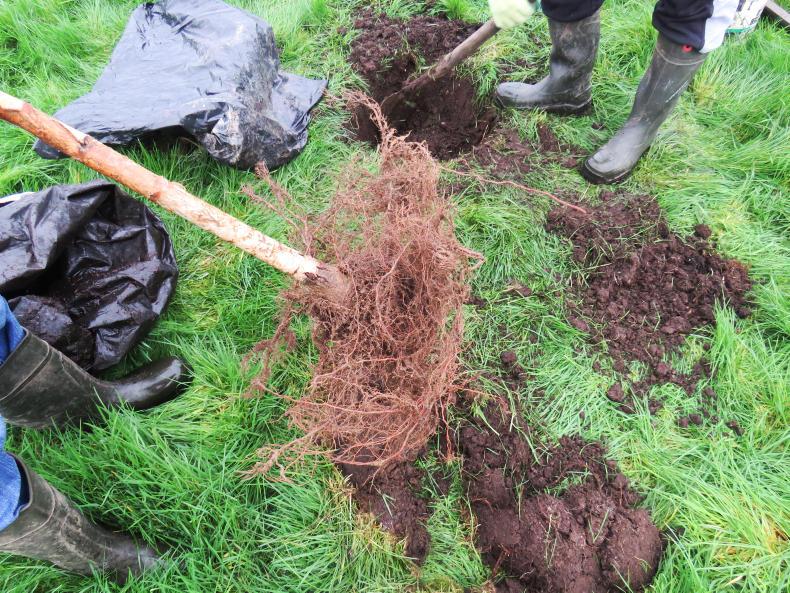
Preparing th site for the tree, and ensuring there is enough space to accomodate the roots, is the next step in planting.
2 Preparation
Once you decide on the trees, the next step is site preparation. For our tutorial, Peadar and Dominic sourced a tree from a local nursery.
The tree was approximately five years old.
The aim when preparing the ground and digging a hole is to ensure there is enough space to accommodate the roots.

Preparing th site for the tree, and ensuring there is enough space to accomodate the roots, is the next step in planting.
“The hole needs to be wide enough so that you do not have to force the roots in and also allows them to grow without too much effort in the first couple of years,” Peadar explained.
When a tree comes inside a pot, the general rule of thumb is to make the hole three times as wide as the pot.
The top sods of earth (scraws) need to be removed and placed aside separately from the rest of the clay, these will come in handy later.
The root collar is the indicator of where to plant back to, the tree should not be planted so deep that the root collar is hidden.
Dominic went a little lower when digging out to plant this tree to allow room for some farm yard manure (FYM) to be placed at the bottom of the hole.
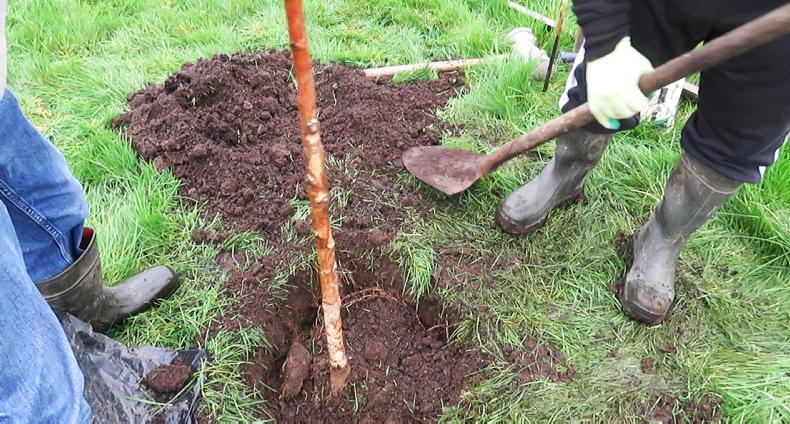
Filling the hole and ensuring the tree roots are covered and gently packed.
3 Fill
Dominic placed two shovels of very well-rotted FYM at the bottom of the hole. He then put the top sods of earth that were removed earlier upside down in the hole. “This leaves the best soil available for the roots as they move downwards,” Peadar explained.

Filling the hole and ensuring the tree roots are covered and gently packed.
The tree is then placed in the hole and the roots are covered over with the remaining soil, all the while being tapped and packed gently to ensure all roots have adequate soil contact.

Stakes can be put down before the tree is planted to ensure roots are not damaged. Peadar and Dominic took extra precautions and used two stakes and a wooden board to hold the tree in place.
4 Staking
Staking is the last job that is required to ensure the tree stays standing. A single stake is usually adequate. It can be put down before the tree is planted to ensure roots are not damaged. Peadar and Dominic took extra precautions and used two stakes and a wooden board to hold the tree in place.
The stake/stakes should always be placed at the prevailing wind side. By using two stakes, Peadar feels the tree is being given better support especially during storms.

Stakes can be put down before the tree is planted to ensure roots are not damaged. Peadar and Dominic took extra precautions and used two stakes and a wooden board to hold the tree in place.
A proper tree tie should be used with the soft side tied around the tree. Over time, as the tree gets bigger the tie should be loosened.
Eventually when the tree can anchor itself even during heavy winds the stakes and tie can be removed.
In the immediate years following, planting the area around the tree should be kept weed free as weeds can compete with the tree for nutrients.
Bark mulch can work well in this regard. Where livestock are present, the tree should be protected with a fence and some farmers put a guard around the bark to prevent damage.
Hedgerow option
Peadar showed me a nice hedgerow he supplied to Harry and Sheila McGowan.
Their son Fergus planted the hedgerow, which separates their garden and the farm lane.
It is a combination of whitethorn, beech, hazel and rosa rugosa. Peadar says the idea behind the hedge is that it is changing all year, unlike evergreen hedges.

Hedgerow option: a combination of whitethorn, beech, hazel and rosa rugosa. The idea behind the hedge is that it is changing all year, unlike ever-green hedges.
A couple of whitethorn plants have been left uncut to allow them grow into trees and to flower. The rosa rugosa adds nice colour and life to the hedge during the year too, Peadar explained.
Trees can be a really nice asset to have on your farm, they are especially nice around the farmyard and can add value to the character of the farm enormously. There are mature deciduous trees on Irish farms dating back 150 to 200 years and some are even older still.
The people who planted those trees would never live to see them fully mature, but still took the time and effort to sow them to benefit future generations farming the land. As these trees fall over time they are a valuable source of timber for fire wood.
By planting trees on the farm, we are creating a lasting legacy for future generations to enjoy. Trees play a vital role in our environment by taking in harmful pollutants and releasing clean oxygen. They also enrich biodiversity acting as a home for birds, small mammals, insects and fungi.
Farmers do not have to sow many trees to make a difference. If your budget allows you could aim to sow a few trees every year.
The cost of trees can vary substantially, with economies of scale a big influence on price. Big trees (6-to-8mm thick) cost €20 to €35/tree from the nursery.
Small saplings (1.5ft long) cost 80c to €1.30. Prices also vary depending on labour and materials.
Saplings require a lot more time and attention to make sure they survive in the intervening years, that is why nurseries provide older trees as an option for customers.
Peadar Conway and Dominic Cassidy from Conway Trees and Hedging gave the Irish Farmers Journal a short tutorial about planting trees, which could come in useful if you are planning on doing something similar.
1 Location
The first decision you have to make when it comes to planting trees is the most suitable site. Some farmers like to plant trees on the driveway to the farmyard, or around the farmyard, as these areas have the most footfall and will get the most attention. If the farmyard is well sheltered with trees it might be worth looking for a suitable location in more secluded areas of the farm.
The trees don’t have to take up space, they can be placed in gaps in an existing hedgerow or in corners that machinery can’t reach. If you are planting on good fertile land trees like oak, beech, hazel, sycamore, horse chestnut and maple are suitable.
In wetter areas, trees such as alder, birch, mountain ash and willow will work well.
Peadar says a mixture of trees is probably the best way to go because you will end up with a nice variation of sizes, colours and activity during the year.

Preparing th site for the tree, and ensuring there is enough space to accomodate the roots, is the next step in planting.
2 Preparation
Once you decide on the trees, the next step is site preparation. For our tutorial, Peadar and Dominic sourced a tree from a local nursery.
The tree was approximately five years old.
The aim when preparing the ground and digging a hole is to ensure there is enough space to accommodate the roots.

Preparing th site for the tree, and ensuring there is enough space to accomodate the roots, is the next step in planting.
“The hole needs to be wide enough so that you do not have to force the roots in and also allows them to grow without too much effort in the first couple of years,” Peadar explained.
When a tree comes inside a pot, the general rule of thumb is to make the hole three times as wide as the pot.
The top sods of earth (scraws) need to be removed and placed aside separately from the rest of the clay, these will come in handy later.
The root collar is the indicator of where to plant back to, the tree should not be planted so deep that the root collar is hidden.
Dominic went a little lower when digging out to plant this tree to allow room for some farm yard manure (FYM) to be placed at the bottom of the hole.

Filling the hole and ensuring the tree roots are covered and gently packed.
3 Fill
Dominic placed two shovels of very well-rotted FYM at the bottom of the hole. He then put the top sods of earth that were removed earlier upside down in the hole. “This leaves the best soil available for the roots as they move downwards,” Peadar explained.

Filling the hole and ensuring the tree roots are covered and gently packed.
The tree is then placed in the hole and the roots are covered over with the remaining soil, all the while being tapped and packed gently to ensure all roots have adequate soil contact.

Stakes can be put down before the tree is planted to ensure roots are not damaged. Peadar and Dominic took extra precautions and used two stakes and a wooden board to hold the tree in place.
4 Staking
Staking is the last job that is required to ensure the tree stays standing. A single stake is usually adequate. It can be put down before the tree is planted to ensure roots are not damaged. Peadar and Dominic took extra precautions and used two stakes and a wooden board to hold the tree in place.
The stake/stakes should always be placed at the prevailing wind side. By using two stakes, Peadar feels the tree is being given better support especially during storms.

Stakes can be put down before the tree is planted to ensure roots are not damaged. Peadar and Dominic took extra precautions and used two stakes and a wooden board to hold the tree in place.
A proper tree tie should be used with the soft side tied around the tree. Over time, as the tree gets bigger the tie should be loosened.
Eventually when the tree can anchor itself even during heavy winds the stakes and tie can be removed.
In the immediate years following, planting the area around the tree should be kept weed free as weeds can compete with the tree for nutrients.
Bark mulch can work well in this regard. Where livestock are present, the tree should be protected with a fence and some farmers put a guard around the bark to prevent damage.
Hedgerow option
Peadar showed me a nice hedgerow he supplied to Harry and Sheila McGowan.
Their son Fergus planted the hedgerow, which separates their garden and the farm lane.
It is a combination of whitethorn, beech, hazel and rosa rugosa. Peadar says the idea behind the hedge is that it is changing all year, unlike evergreen hedges.

Hedgerow option: a combination of whitethorn, beech, hazel and rosa rugosa. The idea behind the hedge is that it is changing all year, unlike ever-green hedges.
A couple of whitethorn plants have been left uncut to allow them grow into trees and to flower. The rosa rugosa adds nice colour and life to the hedge during the year too, Peadar explained.











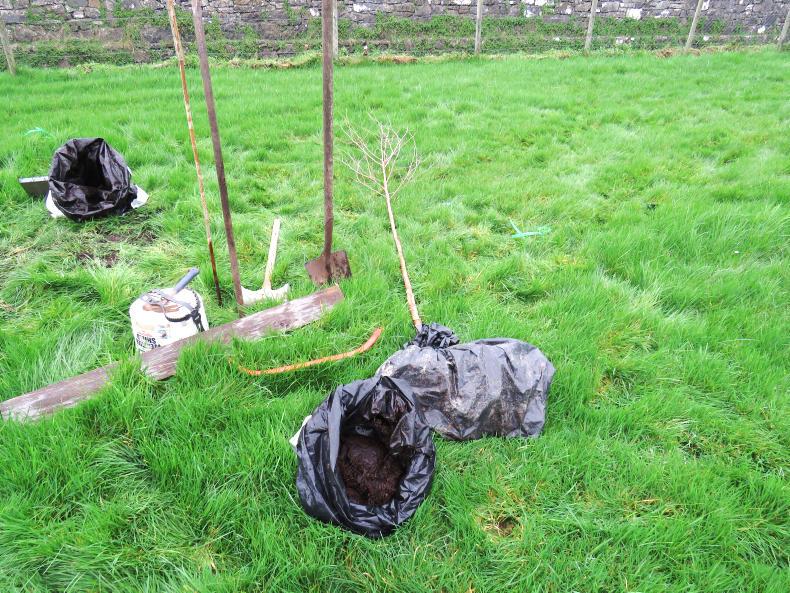


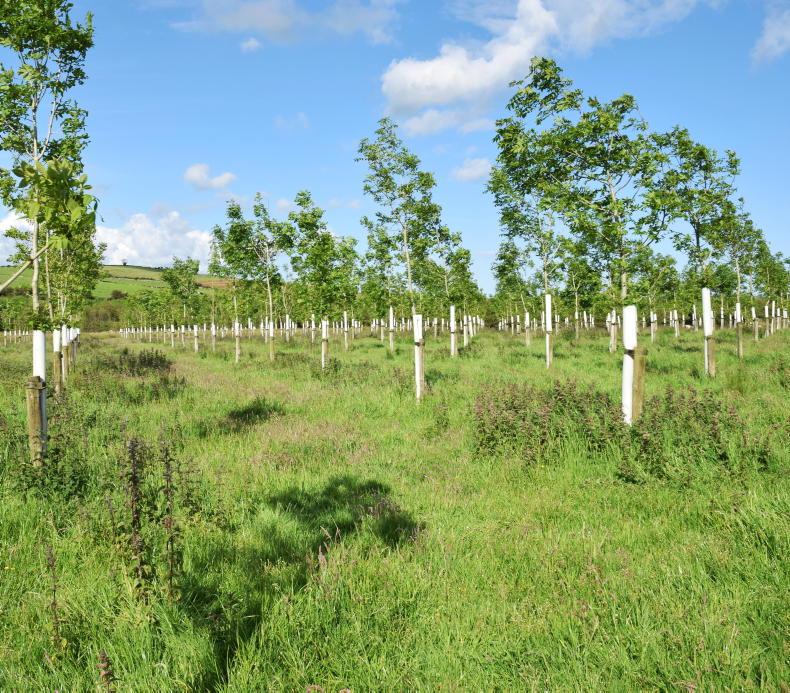
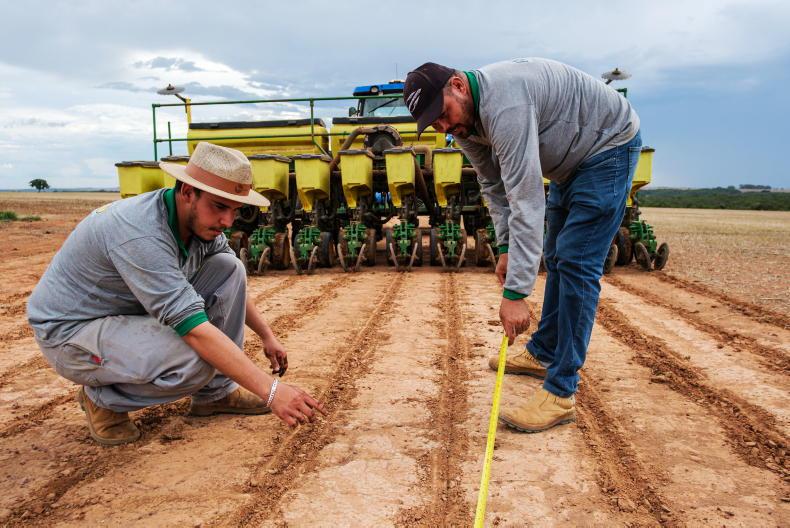
SHARING OPTIONS